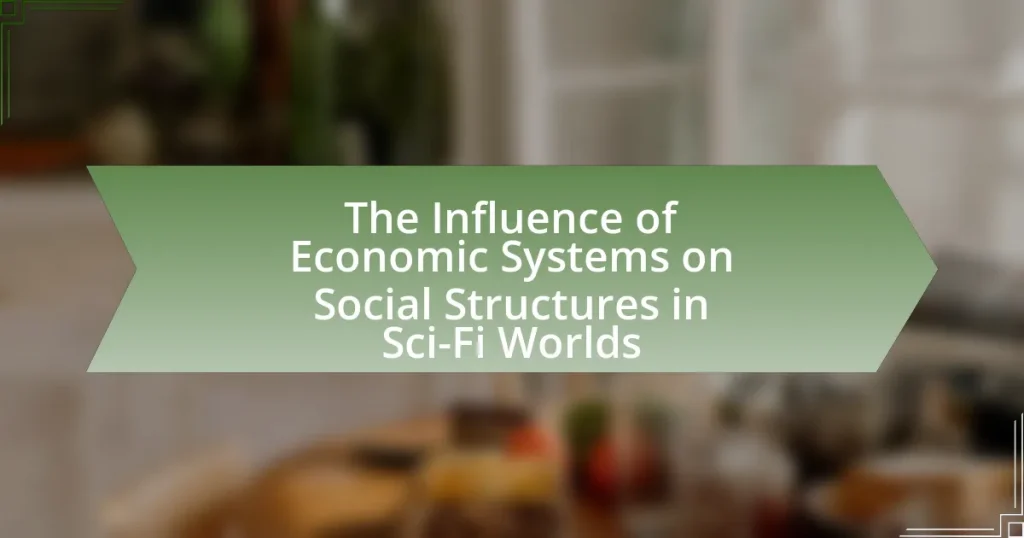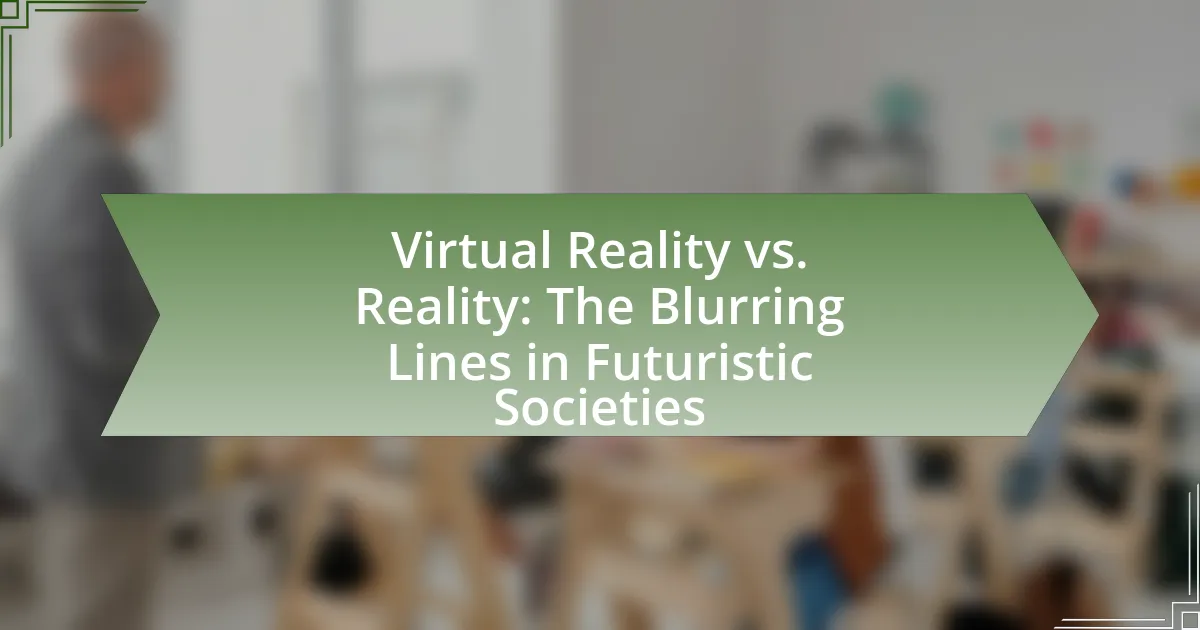The article examines the influence of economic systems on social structures within science fiction worlds, highlighting how these systems dictate resource distribution, class stratification, and societal norms. It explores various economic frameworks, including capitalism and socialism, and their manifestations in narratives such as “Blade Runner,” “The Dispossessed,” and “Star Trek.” Key themes include the impact of economic disparity on social mobility, community dynamics, and character relationships, as well as the broader implications for understanding real-world economic issues. The analysis underscores the importance of these fictional portrayals in reflecting and critiquing contemporary societal structures and challenges.
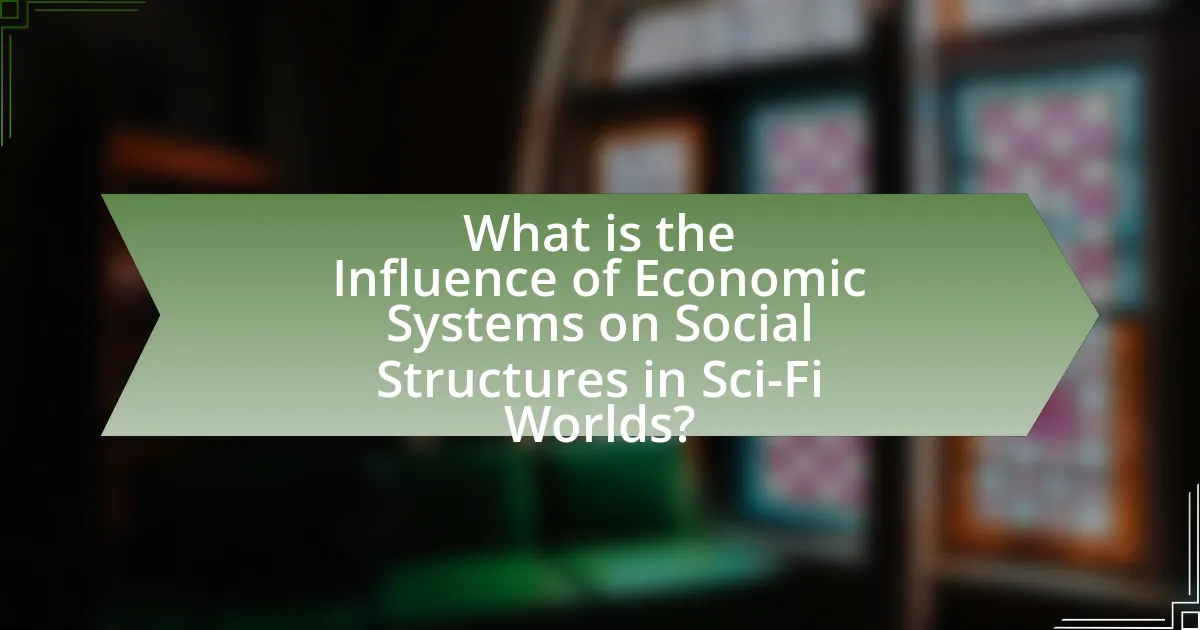
What is the Influence of Economic Systems on Social Structures in Sci-Fi Worlds?
Economic systems significantly shape social structures in sci-fi worlds by determining resource distribution, class stratification, and societal norms. For instance, in George Orwell’s “1984,” a totalitarian economic system enforces strict social hierarchies, where the ruling Party maintains power through control of resources and information, leading to a society characterized by oppression and surveillance. Similarly, in “The Dispossessed” by Ursula K. Le Guin, contrasting economic systems of capitalism and anarchism illustrate how economic frameworks influence social relationships, individual freedoms, and community dynamics. These examples demonstrate that the economic systems in sci-fi narratives not only dictate material conditions but also profoundly affect social interactions, values, and power structures within those fictional societies.
How do different economic systems manifest in sci-fi narratives?
Different economic systems manifest in sci-fi narratives through the portrayal of resource distribution, societal hierarchies, and technological advancements. For instance, capitalism is often depicted in narratives like “Blade Runner,” where corporate entities dominate society, reflecting real-world concerns about corporate power and consumerism. In contrast, socialist systems are illustrated in works like “The Dispossessed” by Ursula K. Le Guin, showcasing communal living and the challenges of equality. Additionally, post-scarcity economies, as seen in “Star Trek,” highlight the implications of advanced technology eliminating resource scarcity, leading to new social dynamics. These representations serve to critique or explore the implications of various economic structures, providing insight into their potential effects on human behavior and societal organization.
What are the key characteristics of capitalism in sci-fi worlds?
Key characteristics of capitalism in sci-fi worlds include the presence of private ownership, market competition, and profit motivation. In these narratives, individuals or corporations often control resources and means of production, leading to wealth accumulation and social stratification. For instance, in “Blade Runner,” the Tyrell Corporation exemplifies monopolistic control over bioengineering, showcasing how corporate power can overshadow individual rights. Additionally, sci-fi worlds frequently depict a consumer-driven society where technological advancements fuel economic growth, as seen in “The Expanse,” where trade and commerce between planets drive conflict and cooperation. These elements illustrate capitalism’s impact on social structures, highlighting themes of inequality and the consequences of unregulated markets.
How is socialism portrayed in futuristic societies?
Socialism in futuristic societies is often portrayed as a system that prioritizes collective ownership and equitable distribution of resources, aiming to eliminate class disparities. In many sci-fi narratives, such as “The Dispossessed” by Ursula K. Le Guin, socialist principles manifest through communal living and shared responsibilities, highlighting the benefits of cooperation over competition. These societies frequently depict advanced technology and automation as tools to enhance productivity while ensuring that the wealth generated is distributed fairly among all citizens, thereby reducing poverty and inequality. Additionally, works like “Red Mars” by Kim Stanley Robinson illustrate how socialist frameworks can lead to sustainable development and environmental stewardship, showcasing a vision where social equity and ecological balance coexist.
What role do alternative economic systems play in sci-fi settings?
Alternative economic systems in sci-fi settings serve to explore and critique contemporary societal structures, often highlighting the implications of capitalism, socialism, or barter systems on human behavior and social dynamics. These systems allow authors to create diverse worlds where economic principles shape governance, class relations, and individual motivations, thereby reflecting real-world issues such as inequality, resource distribution, and environmental sustainability. For instance, in Ursula K. Le Guin’s “The Dispossessed,” the contrasting economic systems of anarcho-syndicalism and capitalism illustrate the complexities of freedom and societal responsibility, demonstrating how economic choices influence personal identity and community cohesion.
Why is it important to analyze economic systems in sci-fi?
Analyzing economic systems in sci-fi is important because these systems shape the social structures and dynamics within fictional worlds. Economic frameworks dictate resource distribution, power hierarchies, and societal norms, influencing character interactions and plot developments. For instance, in works like “The Dispossessed” by Ursula K. Le Guin, contrasting economic systems highlight the implications of capitalism versus anarchism, illustrating how these systems affect individual freedoms and community cohesion. Such analysis allows readers to reflect on real-world economic issues and their potential future trajectories, making sci-fi a valuable lens for understanding societal evolution.
How do economic systems shape social hierarchies in these narratives?
Economic systems shape social hierarchies in narratives by determining resource distribution, access to power, and social mobility. In capitalist frameworks, wealth accumulation often leads to class divisions, where the affluent hold significant influence over societal norms and governance, as seen in works like “Blade Runner,” where corporate entities dominate societal structure. Conversely, in socialist or communal systems, such as depicted in “The Dispossessed” by Ursula K. Le Guin, social hierarchies may be flattened, promoting equality but potentially stifling individual ambition. These economic structures directly influence character interactions and societal roles, reinforcing or challenging existing hierarchies based on the underlying economic principles.
What insights can we gain about our own society through these portrayals?
Portrayals of economic systems in sci-fi worlds provide insights into our own society’s values, inequalities, and potential futures. For instance, dystopian narratives often reflect contemporary concerns about capitalism, such as wealth disparity and corporate control, as seen in works like “Blade Runner,” which critiques consumerism and social stratification. These portrayals can serve as cautionary tales, highlighting the consequences of unchecked economic practices, thereby prompting reflection on current societal structures. Additionally, utopian visions, like those in “Star Trek,” suggest alternative economic models that prioritize cooperation and resource sharing, encouraging discussions about sustainability and social equity. Such narratives reveal the complexities of human behavior in relation to economic systems, ultimately offering a mirror to our societal challenges and aspirations.
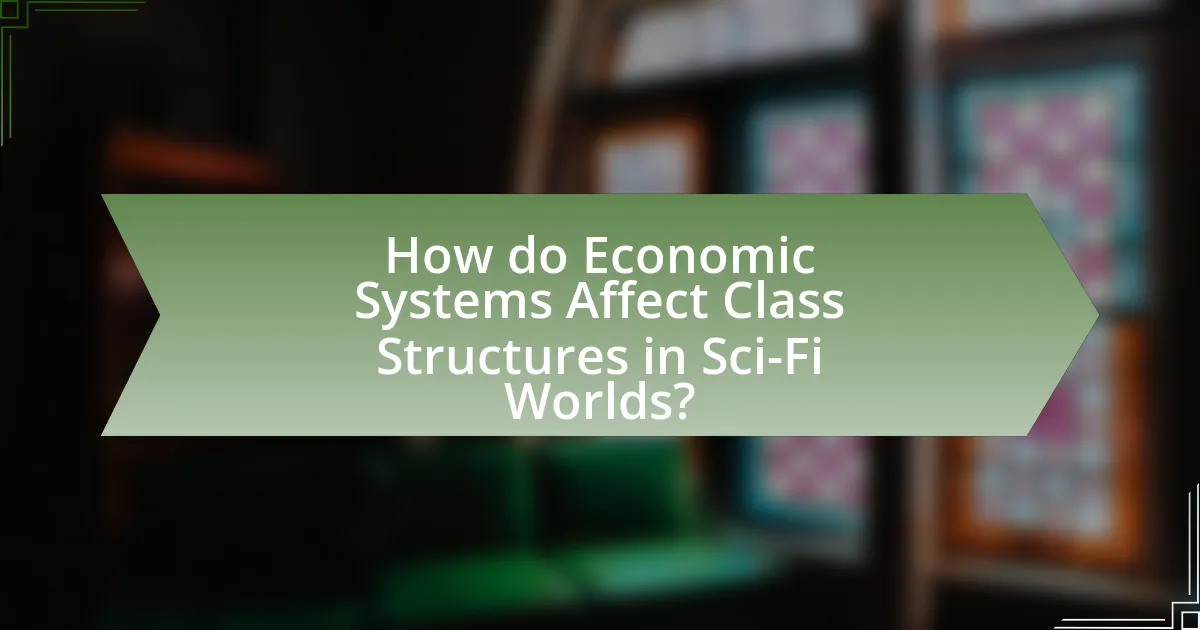
How do Economic Systems Affect Class Structures in Sci-Fi Worlds?
Economic systems significantly shape class structures in sci-fi worlds by determining resource distribution, power dynamics, and social mobility. For instance, in a capitalist sci-fi setting, wealth accumulation leads to distinct class divisions, as seen in works like “Blade Runner,” where the affluent live in luxury while the poor inhabit dilapidated areas. Conversely, in socialist or utopian frameworks, such as in “Star Trek,” resources are shared more equitably, resulting in less pronounced class distinctions. These economic models influence characters’ opportunities and societal roles, reinforcing or challenging existing hierarchies. The portrayal of these systems often reflects real-world economic theories, illustrating how economic structures can dictate social stratification and individual agency within fictional narratives.
What are the common class structures depicted in sci-fi literature?
Common class structures depicted in sci-fi literature include dystopian hierarchies, utopian egalitarianism, and post-scarcity societies. Dystopian hierarchies often showcase a clear division between the elite and the oppressed, as seen in works like “The Hunger Games” by Suzanne Collins, where the Capitol represents the wealthy ruling class while the districts symbolize the impoverished masses. Utopian egalitarianism is illustrated in novels such as “The Dispossessed” by Ursula K. Le Guin, where societies strive for equality and communal living. Post-scarcity societies, exemplified in “The Culture” series by Iain M. Banks, depict advanced civilizations where technology eliminates scarcity, leading to a more fluid class structure. These representations reflect and critique real-world economic systems and their impact on social dynamics.
How do economic systems contribute to the formation of these classes?
Economic systems contribute to the formation of social classes by determining the distribution of resources, wealth, and opportunities within a society. For instance, capitalist systems often lead to the emergence of distinct classes based on ownership of capital and means of production, resulting in a wealthy elite and a working class. In contrast, socialist systems aim for more equitable distribution, potentially reducing class distinctions but still creating hierarchies based on political power or access to resources. Historical examples, such as the class structures in the United States during the Industrial Revolution, illustrate how economic systems can create significant disparities in wealth and social status, reinforcing class divisions.
What examples illustrate the impact of economic disparity in sci-fi?
Examples illustrating the impact of economic disparity in sci-fi include “Elysium,” where a stark divide exists between the wealthy living in a luxurious space habitat and the impoverished on Earth, highlighting issues of access to healthcare and resources. Another example is “Snowpiercer,” which depicts a train divided by class, where the elite enjoy luxury while the lower class suffers in squalor, emphasizing the consequences of social stratification. Additionally, “Blade Runner” showcases a dystopian future where economic disparity leads to a segregated society, with replicants facing systemic oppression due to their status. These narratives reflect real-world economic inequalities and their societal ramifications.
How do economic systems influence social mobility in sci-fi narratives?
Economic systems in sci-fi narratives significantly influence social mobility by establishing the rules and structures that dictate access to resources and opportunities. For instance, in dystopian settings like “The Hunger Games,” a stark divide between the wealthy Capitol and impoverished districts illustrates how a capitalist system can restrict upward mobility for the lower classes, reinforcing social stratification. Conversely, in works like “Star Trek,” a post-scarcity economy promotes equality and allows individuals to pursue personal growth and advancement without the constraints of economic barriers. These narratives reflect real-world economic theories, such as those proposed by Karl Marx, which argue that economic structures shape social relations and mobility.
What barriers to mobility are often depicted in these worlds?
Barriers to mobility often depicted in sci-fi worlds include economic inequality, restrictive governance, and technological limitations. Economic inequality manifests through class divisions, where wealth disparity restricts access to transportation and resources, as seen in works like “Blade Runner,” where the affluent reside in elevated areas while the poor are confined to the streets. Restrictive governance is illustrated through authoritarian regimes that control movement, exemplified in “The Hunger Games,” where districts are isolated and monitored. Technological limitations can also hinder mobility, as in “Snow Crash,” where access to advanced transportation is limited to the elite, leaving others reliant on outdated methods. These barriers reflect the broader themes of social stratification and control within the economic systems of these fictional worlds.
How do characters navigate these economic challenges?
Characters navigate economic challenges by employing strategies such as resourcefulness, collaboration, and adaptation to their environments. For instance, in many sci-fi narratives, characters often form alliances or communities to pool resources, thereby enhancing their collective survival and economic stability. Additionally, they may leverage technology or innovative solutions to overcome scarcity, as seen in works like “The Expanse,” where characters utilize advanced technology to optimize resource management. These strategies reflect the broader theme of how economic systems shape social structures, illustrating that characters must continuously adapt to the constraints and opportunities presented by their economic contexts.
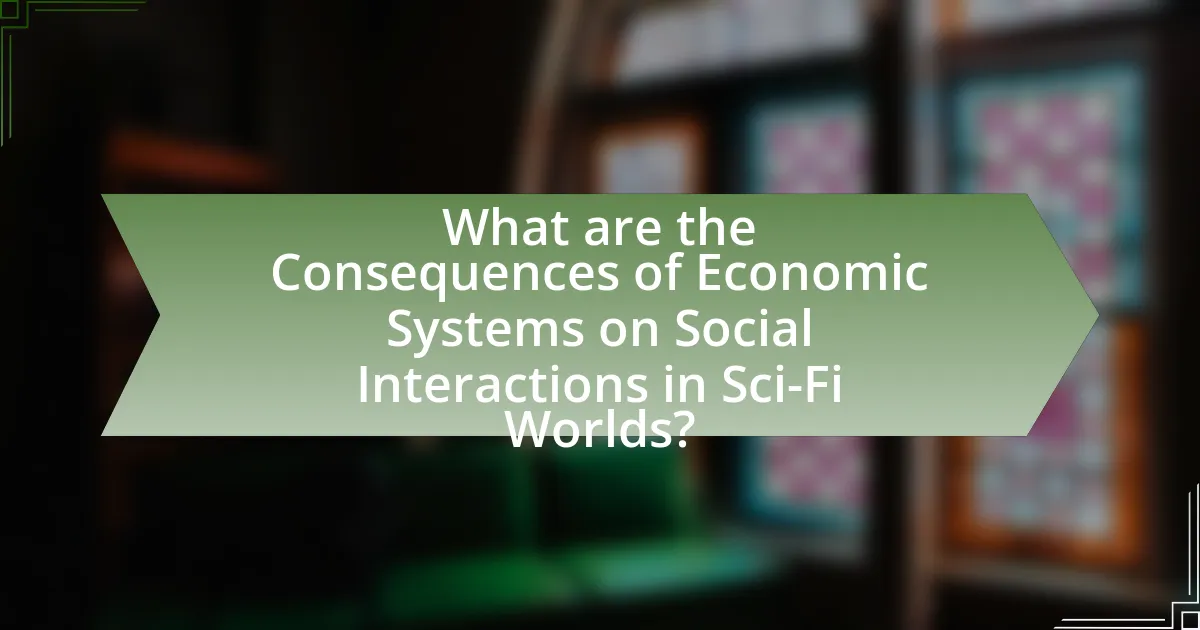
What are the Consequences of Economic Systems on Social Interactions in Sci-Fi Worlds?
Economic systems in sci-fi worlds significantly shape social interactions by determining resource distribution, power dynamics, and societal hierarchies. For instance, in a capitalist sci-fi setting, wealth concentration leads to class divisions, fostering competition and individualism, as seen in works like “Blade Runner,” where the disparity between the affluent and the impoverished creates tension and conflict. Conversely, in a socialist or communal economic framework, such as in “Star Trek,” resource sharing promotes cooperation and collective identity, enhancing social bonds among characters. These economic structures directly influence how characters relate to one another, impacting trust, collaboration, and conflict resolution within the narrative.
How do economic systems shape relationships between characters?
Economic systems shape relationships between characters by defining their roles, power dynamics, and interactions within a society. In sci-fi worlds, characters often navigate complex economic structures that dictate their social status and opportunities. For instance, in “The Hunger Games” by Suzanne Collins, the stark divide between the wealthy Capitol and the impoverished districts illustrates how economic disparity fosters conflict and alliances among characters. The Capitol’s wealth enables it to control resources and manipulate the districts, creating a power imbalance that influences character relationships, such as Katniss’s alliances with Peeta and Gale, which are driven by survival and socio-economic pressures. This demonstrates that economic systems are fundamental in shaping character motivations and interactions, as they reflect broader societal structures and inequalities.
What role does wealth play in character dynamics?
Wealth significantly influences character dynamics by shaping relationships, power structures, and social interactions. In many sci-fi narratives, characters with wealth often wield greater influence and control over others, creating a hierarchy that affects alliances and conflicts. For instance, in “Dune” by Frank Herbert, the wealth of House Atreides and House Harkonnen dictates their political power and the loyalty of other factions, illustrating how economic status directly impacts character motivations and decisions. This dynamic is further evidenced by the portrayal of class struggles, where wealth disparity leads to tension and conflict, as seen in “The Hunger Games” by Suzanne Collins, where the affluent Capitol exerts control over the impoverished districts, driving the narrative’s central conflict. Thus, wealth serves as a critical factor in defining character relationships and the overall social structure within sci-fi worlds.
How do economic pressures affect community bonds?
Economic pressures weaken community bonds by creating stress and competition among individuals. When resources become scarce, people prioritize personal survival over collective well-being, leading to isolation and distrust. For instance, during economic downturns, studies show increased rates of crime and social unrest, as individuals may resort to desperate measures to secure their needs. This shift in focus from community support to individualism diminishes social cohesion, as seen in various historical contexts where economic crises have led to the breakdown of communal ties.
What lessons can we learn from the portrayal of economic systems in sci-fi?
The portrayal of economic systems in sci-fi teaches us that economic structures significantly influence social hierarchies and individual behaviors. For instance, in works like “The Dispossessed” by Ursula K. Le Guin, contrasting capitalist and anarchist societies illustrate how economic systems shape personal freedoms and community dynamics. Additionally, “Snow Crash” by Neal Stephenson showcases a hyper-commercialized world where corporate power dictates social interactions, highlighting the risks of unchecked capitalism. These narratives emphasize the importance of examining economic models to understand their broader societal implications, as they reflect real-world issues such as inequality, resource distribution, and the balance of power.
How can these narratives inform our understanding of current economic issues?
Narratives in sci-fi worlds illustrate various economic systems, providing insights into the consequences of these systems on social structures, which can inform our understanding of current economic issues. For example, dystopian narratives often depict the effects of extreme capitalism or authoritarian socialism, highlighting issues such as wealth inequality and social stratification. These fictional scenarios can serve as cautionary tales, prompting analysis of real-world economic policies and their societal impacts. Historical parallels, such as the rise of corporate monopolies in the late 19th century, reflect similar themes, demonstrating how speculative fiction can mirror and critique contemporary economic challenges.
What practical insights can be drawn for future societal development?
Future societal development can benefit from understanding the diverse economic systems depicted in sci-fi worlds, as they illustrate the impact of resource distribution on social structures. For instance, in the sci-fi narrative “The Dispossessed” by Ursula K. Le Guin, the contrasting capitalist and anarchist societies highlight how economic frameworks shape social hierarchies and individual freedoms. This suggests that equitable resource distribution can foster more inclusive societies, while unequal systems may lead to social stratification and conflict. By analyzing these fictional economies, policymakers can derive strategies to create more resilient and equitable social structures in reality.
